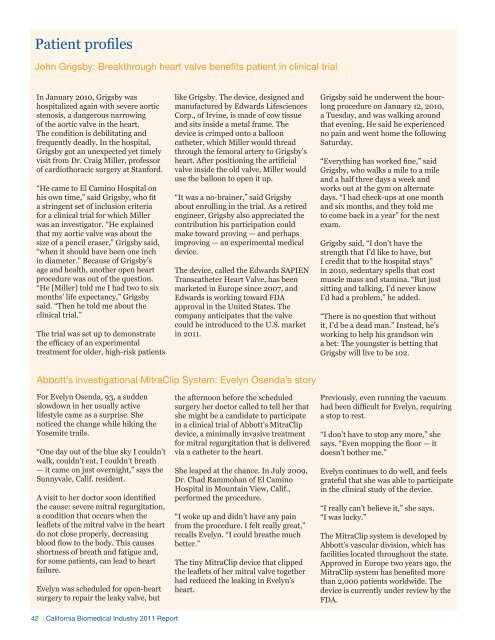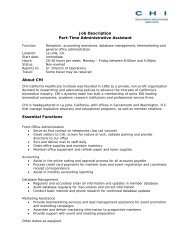California Biomedical Industry - California Healthcare Institute
California Biomedical Industry - California Healthcare Institute
California Biomedical Industry - California Healthcare Institute
You also want an ePaper? Increase the reach of your titles
YUMPU automatically turns print PDFs into web optimized ePapers that Google loves.
Patient profilesJohn Grigsby: Breakthrough heart valve benefits patient in clinical trialIn January 2010, Grigsby washospitalized again with severe aorticstenosis, a dangerous narrowingof the aortic valve in the heart.The condition is debilitating andfrequently deadly. In the hospital,Grigsby got an unexpected yet timelyvisit from Dr. Craig Miller, professorof cardiothoracic surgery at Stanford.“He came to El Camino Hospital onhis own time,” said Grigsby, who fita stringent set of inclusion criteriafor a clinical trial for which Millerwas an investigator. “He explainedthat my aortic valve was about thesize of a pencil eraser,” Grigsby said,“when it should have been one inchin diameter.” Because of Grigsby’sage and health, another open heartprocedure was out of the question.“He [Miller] told me I had two to sixmonths’ life expectancy,” Grigsbysaid. “Then he told me about theclinical trial.”The trial was set up to demonstratethe efficacy of an experimentaltreatment for older, high-risk patientslike Grigsby. The device, designed andmanufactured by Edwards LifesciencesCorp., of Irvine, is made of cow tissueand sits inside a metal frame. Thedevice is crimped onto a ballooncatheter, which Miller would threadthrough the femoral artery to Grigsby’sheart. After positioning the artificialvalve inside the old valve, Miller woulduse the balloon to open it up.“It was a no-brainer,” said Grigsbyabout enrolling in the trial. As a retiredengineer, Grigsby also appreciated thecontribution his participation couldmake toward proving — and perhapsimproving — an experimental medicaldevice.The device, called the Edwards SAPIENTranscatheter Heart Valve, has beenmarketed in Europe since 2007, andEdwards is working toward FDAapproval in the United States. Thecompany anticipates that the valvecould be introduced to the U.S. marketin 2011.Grigsby said he underwent the hourlongprocedure on January 12, 2010,a Tuesday, and was walking aroundthat evening. He said he experiencedno pain and went home the followingSaturday.“Everything has worked fine,” saidGrigsby, who walks a mile to a mileand a half three days a week andworks out at the gym on alternatedays. “I had check-ups at one monthand six months, and they told meto come back in a year” for the nextexam.Grigsby said, “I don’t have thestrength that I’d like to have, butI credit that to the hospital stays”in 2010, sedentary spells that costmuscle mass and stamina. “But justsitting and talking, I’d never knowI’d had a problem,” he added.“There is no question that withoutit, I’d be a dead man.” Instead, he’sworking to help his grandson wina bet: The youngster is betting thatGrigsby will live to be 102.Abbott’s investigational MitraClip System: Evelyn Osenda’s storyFor Evelyn Osenda, 93, a suddenslowdown in her usually activelifestyle came as a surprise. Shenoticed the change while hiking theYosemite trails.“One day out of the blue sky I couldn’twalk, couldn’t eat, I couldn’t breath— it came on just overnight,” says theSunnyvale, Calif. resident.A visit to her doctor soon identifiedthe cause: severe mitral regurgitation,a condition that occurs when theleaflets of the mitral valve in the heartdo not close properly, decreasingblood flow to the body. This causesshortness of breath and fatigue and,for some patients, can lead to heartfailure.Evelyn was scheduled for open-heartsurgery to repair the leaky valve, butthe afternoon before the scheduledsurgery her doctor called to tell her thatshe might be a candidate to participatein a clinical trial of Abbott’s MitraClipdevice, a minimally invasive treatmentfor mitral regurgitation that is deliveredvia a catheter to the heart.She leaped at the chance. In July 2009,Dr. Chad Rammohan of El CaminoHospital in Mountain View, Calif.,performed the procedure.“I woke up and didn’t have any painfrom the procedure. I felt really great,”recalls Evelyn. “I could breathe muchbetter.”The tiny MitraClip device that clippedthe leaflets of her mitral valve togetherhad reduced the leaking in Evelyn’sheart.Previously, even running the vacuumhad been difficult for Evelyn, requiringa stop to rest.“I don’t have to stop any more,” shesays. “Even mopping the floor — itdoesn’t bother me.”Evelyn continues to do well, and feelsgrateful that she was able to participatein the clinical study of the device.“I really can’t believe it,” she says.“I was lucky.”The MitraClip system is developed byAbbott’s vascular division, which hasfacilities located throughout the state.Approved in Europe two years ago, theMitraClip system has benefited morethan 2,000 patients worldwide. Thedevice is currently under review by theFDA.42 | <strong>California</strong> <strong>Biomedical</strong> <strong>Industry</strong> 2011 Report






